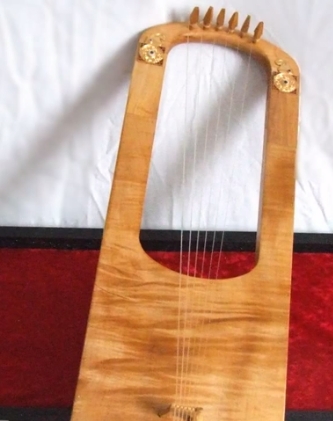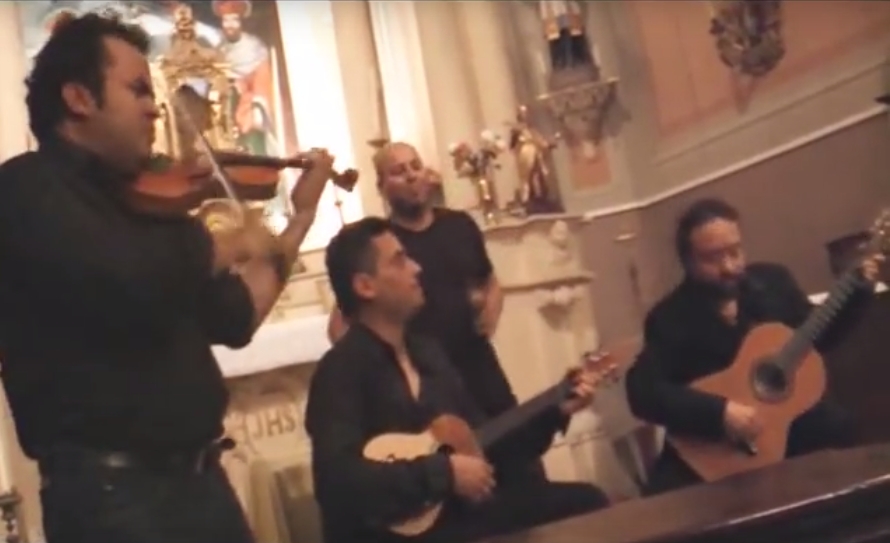One of the oldest musical instruments is the lyre. This instrument is well known as the Anglo Saxon Lyre in the UK, but also as the Germanic lyre. In German it is also known as the Alemannische Leier or Alamannische Leier.
On the homepage of Paul Bultler (http://crab.rutgers.edu/~pbutler/aslyre.html) you can read:
The Anglo-Saxon Lyre is a five to seven (mostly six) string instrument used throughout northern Europe during the early middle ages. Known variously as a lyre, cithara, rotte, hearpe, etc., it has a couple of forms. Primary research on this instrument has already been done in a number of places, including several places on the web, so I’m not going to duplicate that information here (see below for various links). The most famous “example” of this instrument is the Sutton Hoo lyre, small fragments of which were found in a burial mound in SE England, dating from the 7th century C.E., which are presently on display in the British Museum along with a reconstruction of what the instrument might look like (I believe originally made by Dolmetsch).
The lyre of Sutton Hoo has been excavated during the 1930s, a reconstruction of this lyre can be seen in the British Museum in London. This lyre very often served as a model for reconstructions of the Anglo Saxon Lyre.
Michael J King builds reconstructions of lyres including a reconstruction of the Sutton Hoo lyre and presents them with some youtube videos and on his homepage (http://michaeljking.com/sutton_hoo_lyre.htm)
The lyre was especially popular in Germanic tribes in the South of Germany. In 2001 a very good preserved instrument was found during the excavation of a grave in Trossingen. This is the best preserved lyre that has been found until today. The wood used for this lyre has been dated to the late 6th. century, this makes it probable that the instrument has been constructed around 600 A. D.
You can find information and pictures about this instrument in the wikipedia: http://de.wikipedia.org/wiki/Trossinger_Leier
Some weeks ago I had the chance to play a reconstruction of this Trossinger Leier. This instrument is really beautiful. Table and back of the lyre are decorated with a kind of engraved and blackened celtic pattern.
The instrument I played is owned by Eberhard Kummer, a singer from Vienna, Austria. Eberhard Kummer is especially known for his medieval ballads and the medieval Nibelungenlied. Eberhard Kummer used the Trossinger Lyre to accompany a medieval ballad. He used the technique known as “block and strum”. Strings that should not sound are blocked by touching them with the fingers of the left hand, the right hand strums over the strings to produce a chord. A very simple song that can be realised with this technique ist the song: “What shall we do with a drunken sailor.” with chord changes between C-Major and D-Minor.
Here is an example of this “block and strum” technique playd on a lyre by Michael J King:
Anglo Saxon Lyre 2
Another example of the “block and strum” technique can be seen in the following video: http://www.youtube.com/watch?v=ucgIRUBy1Qc&NR=1
The museum of Ellwangen (Germany) does also offer workshops to build a lyre. A report about the construction of a lyre during such a workshop is available at: http://www.dieterle-design.de/leierbau.html
The instrument built during this workshop is used in the following youtube video. In this example the lyre is played with a simple picking technique of the right hand:
Alamannische Leier
The lyre seems to be a very simple instrument, but it offers many different playing techniques and it is possible to play very elaborate and beautiful music on a lyre.
As an example you can watch the following video of an ancient lyre. The player uses many different techniques that could also be used on a Germanic or Anglo Saxon Lyre, including picking the strings with both hands, strumming with a pick, picking with the left hand and strumming with the right hand at the same time, even tremolo on a single string and picking chords with the left hand, glissando – its really fascinating:
EGYPTIAN FOLK SONG PLAYED ON ANCIENT LYRE! (1 of 4)
Playlist Sutton Hoo Lyre
Addtional information
I have collected several interesting links about the lyre in my pinboard link colection: http://pinboard.in/u:mandoisland/t:leier/



